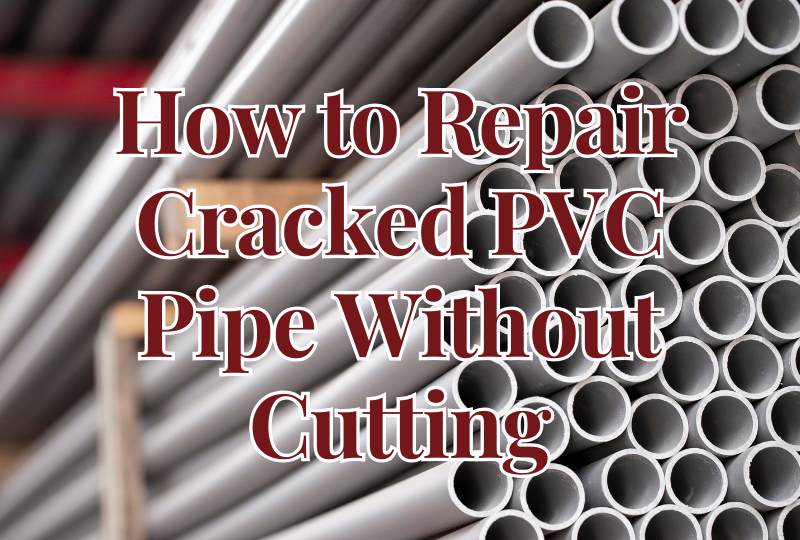The Best Fluffy Pancakes recipe you will fall in love with. Full of tips and tricks to help you make the best pancakes.

5 Ways to Repair PVC Pipes

A broken PVC pipe can cause water leakage or a sink malfunction. To get your sink up and running again, we’ve put together five ways to help you repair your PVC pipes. PVC pipes (polyvinyl chloride pipes) are known for their strong and lightweight properties that make them a long-lasting solution for sewerage, plumbing, and irrigation. PVC pipes, which are usually recognizable by their white or off-white color, are bonded with fasteners and a solvent cement that melts the surface layer of the pipes and bonds the material together.
The most commonly used drain pipe is PVC, which is known for its ease of use and affordable price. In most cases of PVC damage, it is possible to repair the existing pipe to prevent leakage. However, if the damage is too extensive, the pipe may need to be completely replaced. To help you repair or replace PVC pipes, we have outlined five ways to repair or replace the pipe.
Common Causes of PVC Leaks
Here are some of the most common reasons for PVC pipe repair and replacement:
Improper installation: If the PVC fitting is not properly mounted on the connecting pipe, leakage may occur. This is usually caused by a loose fixation that allows water to pass through.
Wrong glue – Be sure to buy the right PVC cement so that it does not spoil prematurely. Before choosing an adhesive, read the label to make sure it is designed to adhere to PVC. Even if you choose the right glue, it will deteriorate over time and need to be repaired.
While PVC is frost resistant, it can become brittle and damaged in extreme winter weather. If you live in an area with low temperatures, insulate the pipes to prevent freezing.
How to Fix Hairline Cracks in Concrete Driveway
5 Simple Steps, How to Repair PVC Pipes Without Cutting?
Step 1:
The first step is to find out at what point the PVC pipe was damaged. Liquid leakage can be detected at the point where the PVC pipe has been damaged. Carefully identify any or all of the damaged areas. After that, take a marker or grease pen and mark the damaged area. You can draw a straight line or draw a circle around a broken or damaged area.
This is important so that you can find out the damaged area later to check if it has been repaired correctly or not. Now turn off the fluid supply to the PVC pipe so that the repair process can be carried out. If you are repairing the supply line, close the level to cut off the supply for a while. If it’s a drain hose, stop pouring water or something similar into the drain pipes for a while.
Step 2:
The next step is to create suction power on the PVC pipe. To create suction power in the pipe, you need to seal or close each hole in the PVC pipe. You can use drain plugs to cover the drain holes, or you can insert rubber plugs into all the holes in the hose. This happens because, during the repair, it is necessary to close all the holes first to stop the flow of liquid. If liquid gets into the pipes, it is simply impossible to repair the damaged PVC pipe without cutting.
Therefore, you need to use every method to make the pipes without liquid. However, only release or open a drain or access hole. This is done in order to create suction later and continue with the repair process. However, care must be taken to ensure that no liquid flows through an open hole in the pipe. Otherwise, it will affect the repair of damaged or leaking PVC pipe.
Step 3
In the third step, you generate suction power with a vacuum pump. Take any vacuum cleaner, wet or dry, and put the hole in an open hole in the PVC pipe drainage system that we intentionally left open. When you’re done, plug the vacuum/pump switch into the outlet and activate the button. The vacuum begins to be sucked into the tube, and there is a strong suction.
Step 4:
Take the brush provided and dip it well in the PVC primer available on the market. You can buy the included PVC brush and primer at any plumbing store near you. Then place the brush (dipped in a primer) over the damaged edge or leak on the PVC pipe. Thanks to the suction power generated by the vacuum, the primer pulls powerfully into cracks or damaged pipes and fills them well.
Security Gates: What Are Your Options?
What is an ADA Shower?
The suction power also helps to clean the inside of the PVC pipe. This helps to remove dust particles or debris in the pipe. Not only that, but it also helps to clean any liquids that remain in the PVC pipe. When all dusts, liquids or debris are removed from the inner boundary of the pipe and properly prepared, our goal is achieved.
Step 5:
Once you’ve completed the above steps, take the included brush again and dip it well into the PVC pipe repair glue. This glue is also available in the market and can be purchased at any store or plumbing store. It’s also not too expensive, so you can easily get it without breaking your budget. Once the included brush is fully immersed in the glue, place it back on the damaged or leaking part.
Then insert the vacuum tube back into the open hole and turn on the switch. When the switch is turned on, the glue slides forward due to the force exerted by the vacuum. In this way, the glue reaches all the cracks and a layer of glue is applied to it. After that, turn off the switch on the vacuum cleaner and leave the hose as it is for a few minutes.
Tips to avoid cracks in PVC pipes:
Consider the following tips to avoid cracks in PVC pipes in the future:
To protect pipes from high temperatures, insulate them.
Use proper installation methods to avoid damage during installation.
Avoid excessive force when tightening parts or valves.
Check the pipes regularly for signs of wear or damage.
Inference:
Repairing a damaged PVC pipe without cutting it can save you time and money, and it’s a simple process that anybody can complete. By following the directions in this manual and taking preventative measures, you can keep your PVC pipes in good condition and save money on repairs. If you have any questions or concerns, speak with an experienced plumber or a do-it-yourself professional.









[…] How to Repair Cracked PVC Pipe Without Cutting […]
[…] How to Repair Cracked PVC Pipe Without Cutting […]